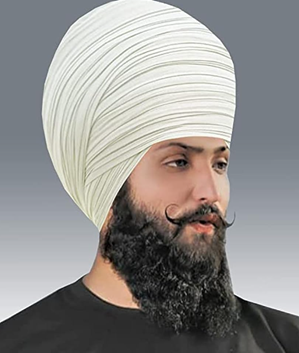Types of Turbans — Everything you need to know about Turbans
The turban, a majestically wrapped piece of cloth is an integral part of Sikh Identity. It holds a profound significance in Sikh culture which represents faith, honor, and identity. Turbans are a type of headwear that is most typically found in Asia.
There are numerous types of turbans which vary in style, color, and design. You can purchase these turbans online and explore a world of authentic Sikh heritage, craftsmanship, and style, all at your fingertips.
In this article, we will talk about all the various types of turbans, their cultural significance among Sikhs, and the various ways to wear them across different regions of the world. So let’s get started.
1. Dastaar (The common Sikh Turban):
The dastaar is the most common type of Sikh Turban that is worn by both men and women. It is typically made from a single piece of cloth which can be approximately 4–6 meters long and meticulously wrapped around the head.
Different regions and communities within Sikhism may have variations in how they tie the dastaar, leading to distinct styles. The process of tying a Dastaar is intricate and can vary among individuals based on their region, age, and personal aesthetic preferences.
· Length: Approximately 4–6 meters long (varies based on individual preference)
· Fabric: Typically made from a single piece of sturdy cloth, commonly cotton or silk blend.
2. Patiala Shahi Pagg:
The Patiala shahi Pagg is a majestic and voluminous style of turban that originated in the city of Patiala in Punjab, India. This type of turban is distinguished by its multiple layers of cloth, height, and sharp folds, giving it a crisp, starched appearance and creating a regal and impressive appearance.

This style is popular among Sikh men during festive occasions, cultural celebrations, and traditional ceremonies, where it serves as a symbol of pride, honor, and cultural heritage.
· Length: Varies depending on desired volume, but generally requires a longer cloth length, around 6–8 meters.
· Fabric: Often made from thicker cotton or silk fabric to hold the shape and volume effectively.
3. Amritsari Pagg:
Originating from the city of Amritsar in Punjab, India, the Amritsari pagg is known for its elaborate and voluminous style. It features a distinctive fold at the front and is often tied with a thicker cloth, creating a regal look.

The Amritsari pagg is often worn during special occasions and religious ceremonies, symbolizing pride and devotion. This is also favored by many Sikh men as a daily attire choice, reflecting a strong connection to their cultural roots and a sense of reverence for their heritage in everyday life.
· Length: Generally, requires a longer cloth, around 5–7 meters.
· Fabric: Thicker and stiffer fabrics like khadi (handspun cotton) or brocade are commonly used to achieve the distinctive fold and regal appearance.
4. Gol Pagg
The gol dastaar meaning “round turban” is a simple yet elegant style commonly worn by Sikh men and women. It is often worn by children and young adults and is seen as a practical style for everyday wear.

The gol dastaar is favored for its versatility and comfort, making it suitable for everyday wear as well as special occasions. Sometimes this pagg is worn during sports and physical activities due to its more secure fit.
· Length: Typically, around 4–5 meters.
· Fabric: Soft cotton or silk fabric, providing comfort and ease of tying while maintaining a neat round shape.
5. Dumala:
The Dumala is a traditional Sikh Turban worn by Nihang warriors and devout Sikhs who follow a strict code of conduct. This large round turban is often associated with Nihang Sikhs, a warrior order known for their distinctive attire.

This turban is much larger and fuller than other styles, involving two pieces of cloth. Tying a dumala requires skill and practice, as it involves multiple layers of cloth arranged in a specific manner to create its signature appearance.
· Length: Requires two pieces of cloth, each around 4–5 meters long.
· Fabric: Sturdy cotton or khadi fabric for the base layers, with softer cotton or silk for the top layer.
6. Keski
This is usually a smaller version of Dumala, often made of softer materials and less voluminous than the Dumala. This is frequently worn by Sikhs who particularly follow the Sikh doctrine of wearing a turban at all times. This is a more manageable form of a turban and represents humility and commitment to Sikh traditions.
· Length: Smaller than a Dumala, around 3–4 meters.
· Fabric: Soft cotton or silk fabric for comfort and manageability.
7. Parna

Unlike the formal turban, the Parna is a casual style of turban that is worn most frequently at home and while performing physical labor. This kind of turban can be easily tied and is made from lighter, softer materials than those usually used for formal turbans. Because of its ease of tying and practicality, it is also preferred by older Sikhs as well and is often seen as a symbol of humility and simplicity within the Sikh community.
· Length: Variable, but usually around 3–4 meters for ease of tying.
· Fabric: Lighter cotton or cotton-synthetic blends for flexibility and comfort during casual wear and physical activities.
8. Morni Pagg
Named after the peacock (Morni means “peahen” in Punjabi), the Morni Pagg is characterized by a tapering shape and a fan-like curve at the top, resembling a peacock’s plume. This style is often sported by younger Sikhs and implies dynamism and flair. The folds at the base are wider, which constrict as they ascend towards the crest of the turban.
· Length: Typically, around 4–6 meters, depending on desired volume and style.
· Fabric: Cotton or silk fabric with a bit of stiffness to hold the fan-like curve at the top, often with vibrant patterns or designs for a stylish look.
Conclusion
The wide array of Sikh turbans is a rich tapestry of history, geography, and individual expression within the Sikh community. Each style carries its own set of connotations and historical backdrops, reflecting the diverse yet unified identity of Sikhs across the globe. While the outer differences are apparent, the essence and underlying reasons for wearing turbans — honor, integrity, and the upholding of Sikh values — remain consistent throughout.
For Sikhs, the turban is far more than a piece of traditional headwear. It is a crown of spirituality, a banner of faith, and a symbol of equality. Each knot represents a commitment to the teachings of the Gurus, and every layer is a pledge to uphold righteousness and justice. Thus, the turban is an embodiment of the Sikh way of life — a life of courage, piety, and undying devotion to truth.
